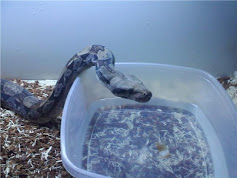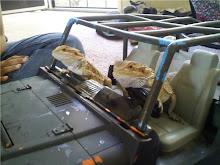Quick facts
Photo Bytes
Class: Reptilia (Reptiles)
Order: Squamata
Family: Boidae
Subfamilies:
• Boinae
• Erycinae
Genera: 11
Species: 41
Size: longest—anaconda Eunectes murinus, up to 30 feet (9 meters); shortest—Arabian sand boa Eryx jayakari and elegant sand boa Eryx elegans, both up to 16 inches (40 centimeters)
Weight: heaviest—anaconda, up to 280 pounds (127 kilograms)
Life span: up to 35 years
Number of young: 4 to 40, depending on species
Gestation: 50 to 180 days, depending on species
Size at birth: typically 6 to 24 inches (15 to 61 centimeters), depending on species; up to 2 feet (0.6 meters) from large anaconda mothers
Age of maturity: 3 years
Conservation status: Round Island keel-scaled boa Casarea dussumieri, Madagascar ground boa Acrantophis madagascariensis, and Madagascar tree boa Sanzinia madagascariensis are some of the endangered boas; many others are vulnerable.
Fun facts
• Boa "a large serpent” in Latin.
• Female anacondas grow much larger than the males.
• Boa constrictors like to eat bats! They catch them by hanging from tree branches or the mouths of caves and knocking the bats out of the air as they fly by.
• When some boa species want to mate, several males coil around a female in a ball and wrestle with one another for up to two weeks before one wins—or the female makes a choice.
• The rosy boa Lichanura trivirgata and the rubber boa Charina bottae are the only two species of boas native to the United States.
See them
Range: western North America, Central America, South America, Africa, Madagascar, western Asia, and Pacific Islands
Habitat: rain forests, swamps, woodlands, grasslands, savannas, and semidesert scrublands
.
Boas, pythons, and anacondas: What’s the difference?
Because boa constrictors, reticulated pythons, and anacondas are some of the biggest snakes in the world, many people get confused about which is which. The first thing to note is that the anaconda is a species of boa, not a separate type of snake. That leaves two groups, the boas and the pythons. These snakes have some things in common: they are constrictors, killing their prey by wrapping around it and suffocating it, and they are considered primitive snakes with two lungs (most snakes only have one) and remnants of hind legs and pelvic bones. But they have differences, too. Pythons have one more bone in their heads than boas do and some additional teeth, and pythons are found in the Old World (Africa, Asia, Australia) while boas live in both the Old World and the New World (North, Central, and South America). One of the biggest differences is that pythons lay eggs while boas give birth to live young.
Putting the squeeze on dinner
Boas are constrictors, meaning that they grab their prey with their teeth, then quickly wrap their coiled bodies around the prey and squeeze. But they don’t actually crush the prey and break its bones. They just squeeze tightly so that the prey animal’s lungs cannot expand and it suffocates. The snake then begins the leisurely process of unhinging its jaw and swallowing the prey whole, usually headfirst. Rhythmic muscular contractions pull the prey down the snake’s throat and into its stomach. How does the snake breathe while its mouth is full? It has a special tube in the bottom of its mouth that remains open to one side to take in air.
A hot meal
Boas are ambush hunters. They remain still and hidden until a possible meal comes close, then strike forward quickly to catch it. Boas flick their tongues in and out to catch scent particles from the air. This way of "smelling” helps them find their prey. Most species also have special temperature-sensitive scales around their mouths, with lots of nerve endings that can sense the heat of a nearby animal. This allows them to find prey even in the dark or among dense foliage. The tree boas have "pits,” or holes, along their mouths that do the same thing, like their relatives the pythons do. Depending on the size of the snake, boas may eat rodents, birds, lizards, frogs, and small to medium-sized mammals like opossums, monkeys, pigs, or deer. Some anacondas have been known to eat animals as large as a young tapir or even a caiman. At the San Diego Zoo, our boas eat rodents and rabbits that have been killed for them.
A snake that gives birth
Boas do not lay eggs. Instead, they give birth to live young. The young are attached to a yolk sac and surrounded by a clear membrane, not a shell, as they develop in their mother’s body. That way they are kept at a fairly constant temperature and are protected from predators. When the young are ready to be born, they are pushed out an opening called the cloaca. They are still surrounded by the protective membrane and must break it open. Then they are on their own to start protecting themselves (usually by hiding at first) and to find food. Most are smaller versions of the adults and instinctively know how to survive on their own.
"Walk” a straight line
Because of the large size many boas can reach, they move by traveling forward in a straight line, which is known as "rectilinear progression.” This is accomplished by stiffening the ribs to provide support, then lifting a set of ventral (on the belly) scales and moving them forward so the loose ends grip the surface, pushing the snake ahead. This type of movement works on the ground as well as in trees, and boas can even climb smooth surfaces. They can’t move very fast, though, only about 1 mile per hour (1.6 kilometers per hour) on open ground. But since they don’t have to chase their food, they don’t need to travel quickly.
Not the bad guys
Boas often appear in movies and stories that take place in the jungle, usually as the "villain” sliding menacingly through the trees. That’s probably because these big snakes make a big impression! But boas are usually pretty quiet and calm and don’t deserve their nasty reputation. They are not venomous, and many do not live in jungles. Boas are found in a variety of habitats, including open woodlands—like the rainbow boa Epicrates cenchria—and rocky, semi-desert scrublands—like the Egyptian sand boa Eryx colubrinus. The ones that live in dry environments usually hang out in rock crevices or in underground burrows made by other animals. The ones that live in forests blend into the leaf litter on the ground to stay hidden. All in all, a boa would rather avoid people than go looking for trouble!
About Me
Boa.jpg)
- iReptiles
- This site is for educational purposes only, and to built a reptile community for all the reptile lovers out there. I also do reptile rescue, reptile sitting (short and long term), and reptile extraction, lol but it happens. I'm in San Diego, and if you need to give up your reptile, for whatever reason, give me a call at 619-971-6672, and my name is Cisko.
Subscribe to:
Post Comments (Atom)



No comments:
Post a Comment